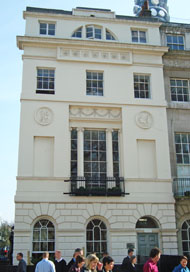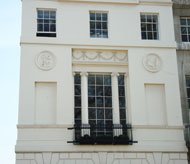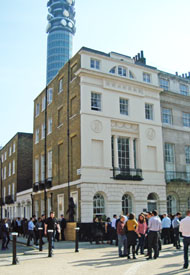Specialist. Later, Out-Patients only
The London Skin Hospital opened in 1887 at 47 Cranbourne Street.
In 1891 it moved to 40 Fitzroy Square, where an in-patients department was opened. The Hospital offered treatments using X-rays, high-frequency electric current and ultraviolet light for conditions such as lupus vulgaris (TB of the skin), rodent ulcers and psoriasis.
In 1929 three young brothers died shortly after treatment for ringworm at the Hospital. The attending physician had prescribed the rare drug thallium acetate, making out his prescription according to the metric system of weights. The Hospital phramacist converted the metric numbers to the apothecary system, but used scales instead of metric weights. The decimal point was misplaced, thus increasing the dose tenfold. The deaths of the boys occurred almost immediately, before those present could determine the cause.
During WW2 the Hospital carried on under considerable difficulty due to shortage of staff and damage to the buildings. The premises received bomb damage in 1940, 1941, 1944 and 1945. The adjacent premises were completely demolished on one occasion.
While providing a valuable service for thousands of patients and employing some well known dermatologists, the Hospital never achieved the status that similar institutions with links to a teaching hospital did. In 1948 it joined the NHS under control of the Paddington Group Hospital Management Committee.
The Hospital remained functional, but as an Out-Patients Department only, from 1950 to 1958, when the Paddington Group decided to close it. The building became the eastern part of the London Foot Hospital, housing its academic departments, in 1959.
Present status (March 2009)
No. 40 has been refurbished and is now a private treatment clinic - the Advanced Hair Studio.



No. 40 Fitzroy Square, with its elegant balcony. The Post Office Tower in Howland Street can be seen looming in the distance.
Wigmore AW 1904 Some typical examples of Roentgen-ray and high-frequency treatment with observations thereon. British Medical Journal 1(2260), 944-945.
http://query.nytimes/com
www.bad.org.uk
www.iht.com
Return to home page